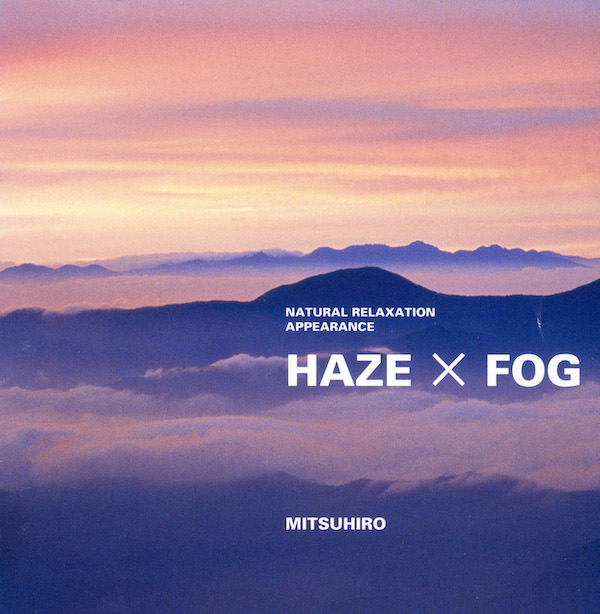
You know, sometimes as I choose to share a bit of music, what strikes me to do might be things that might not strike others quite the same. One of those things, I’ve got to say, is that I’m still a big fan of album covers and album titles that invite your mind to wander. Japanese albums like Green, Mio Fou, Motohiko Hamase’s Intaglio (to name those that immediately come to mind) instantly, holistically, place you the listener in a certain frame of mind. Those are masterpieces of visual and sound aesthetic finding common ground. Such is the thinking that brought me to needling y’all to explore Mitsuhiro Nagano’s early work with Synforest and specifically his 霞と霧 / Haze × Fog.
To refresh your memory, not-so-hidden in an earlier post, under the review of photographer Masami Ota and composer Masumi Takahashi’s collaborative work (1995’s シンフォレスト 美瑛・富良野 (Biei-Furano)), was a final paragraph suggesting you explore other works created under the ideas of the Sound Synforest BGV/BGM company. It was in this bit I linked to Mitsuhiro and Yukihito Arai’s 霞と霧 (Haze x Fog).

As we’ve all experienced in our e-existence, how things get shared in our era (and in that medium) can also define how things get unshared. As record collectors become, sadly, more and more “gatekeepers”, so do music publishers meet out who can view or what channels can survive any/all three copyright strikes. And for those who use YouTube as their main/only form to express their collection, as you can imagine, such policing can make any channel’s existence exist on a knife’s edge.
So, that’s the world Mitsuhiro’s 霞と霧 / Haze × Fog short e-existence lived in. At the time, under Xerf Xpec’s channel (now found here) it had its moment. And then, just as quickly, it appeared that this was one of those albums swept under when a YouTube channel felt the fury of a much larger copyright sweep. With media itself so wringed into streaming ecosystems, somehow, stuff like this could just as easily have resigned itself into the aether. This begs the question: Why put all such eggs into such a basket? Can there be other ways to keep such works alive?
My introduction to Mitsuhiro’s work came via his work with Toshiya Sukegawa and his BIOÇIC institute of Environmental Music. A native of the Tokyo suburb, Higashimurayama, Mitsuhiro graduated from the Tokyo’s College of Music before he tried to explore computer music production. Under the tutelage of Toshiya, Mitsuhiro studied the effects of alpha and 1/f fluctuation waves (basically “pink” noise) on listeners through music.
Working from his home studio at the base of Sayama Hills, the “Totoro Forests” of Hideo Miyazaki, so to did Mitsuhiro develop a special music that hinted at his connection with the verdant ecological environment around him and his learned practice in classical composition and contemporary sound design. Transitioning from mostly making commercial music, designing interstitial music and sounds for corporate clients, in the span of a year Mitsuhiro would contribute a vast library of healing music for the Bioçic Music institute.
In 1994, the popularity of CD-ROM media as a means to make a living as a music composer afforded Mitsuhiro the opportunity to really zero in on his attempt to combine music with visual media. Apollon’s Sound Synforest was just one of those Japanese multimedia labels trying to give life to such compositions not just via a classic “album” release but through VCDs, DVDs, and other visual media. It was there that Mitsuhiro’s quite visual-sounding music was able to exist in a way that spoke to his sensibilities.
Looking back, it appears that Mitsuhiro was in tune with the newform “wellness” or self-help crazes that were bubbling up. Of the music he would create, much of it touched on themes of relaxation, self-control, stress relief, and myriad forms of holistic therapy. However, of the best music he’d create, under his own name works like Labyrinth – 光の迷宮 and 霞と霧 / Haze × Fog could function outside of that ecosystem as something more than mere BGM.
1995’s 霞と霧 / Haze × Fog would follow the aesthetic template set forth by Masumi Takahashi’s シンフォレスト 美瑛・富良野 (Biei-Furano). Featuring the photography of Yukihito Arai, of snapshots of fog descending on Japanese mountainscapes and haze rising from rice fields, 霞と霧 / Haze × Fog provided Mitsuhiro a visual point to hone in on music that could evoke and add that movement to such, seemingly, static media. Making, ostensibly, music for a transitional atmosphere led to Mitsuhiro’s inspiring take on ambient music.
You hear it in the reverential opener, “幽谷 / Deep Valley”. Here electronic synthesizers conjure wide, lingering sonic beds that seem to evoke that feeling/sensation of atmosphere descending. It’s a gorgeous album that uses tone poems to instantly play out the descriptor it’s leading with. A song like “春霞 / Haze” easily portrays the wispy, thin, holistic idea one thinks of that early morning environmental effect. “霧 / Fog”, or a track like “迷宮 / Labyrinth”, sonically, favor thicker, wider, slow-moving sonics that owe a bit of allegiance to early Eno experiments where textural shifts speak louder than tonal ones. This is music, once again, first and foremost.

The beauty of Mitsuhiro’s music is that it’s another one of those albums that fills the gap between “furniture music” and ambient music. There are days when you need this interior music to both paint a picture and round out an existing one. The mystery behind it lies in the notes the listener adds when they really center themselves to make space for it. Here’s to hoping that whatever we can do has it sticking around longer than a short spell.
